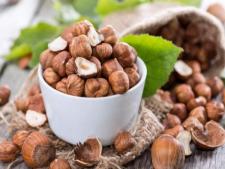-

Hazelnuts
| Food | Percentage of DRI per 100 grams | |
|---|---|---|
| manganese | 268 | |
| copper | 192 | |
| vitamin E | 100 | |
| iron | 59 | |
| magnesium | 40 | |
| vitamin B6 | 30 | |
| calcium | 11 | |
| vitamin C | 10 | |
Hazelnuts are sweet, and incredibly nutritious edible kernels from the "birch" or Betulaceae family of trees. “Filbert” (C.maxima) is similar in kind, and related to the common hazel but only differing in having its nut totally covered by its tubular involucre. In Britain, both of these nuts are in general enjoyed as "cobnuts."
Hazel tree begins producing fruits about three years after plantation. During each spring season, the tree bears attractive inflorescence (catkins) consisting of clusters of monoecious (single sex) flowers arranged closely along its central stalk which subsequently develop into fruits by autumn.
shelled hazelnut
Fiberts, shelled-close up view.
Photo courtesy: katerha
Hazels appear in clusters. Each nut is held inside the short leafy involucre or "capsule" enclosing about three-quarters of the kernel. Each yellow-brown color kernel is roughly spherical to oval in shape, about 1.5-2 cm long and 1.2 -2 cm broad, featuring a light scar at its base. They generally fall out of this leafy involucre or capsule once ripe about 7-8 months after pollination.
Hazelnut oil, extracted from the kernels, has been used in as base or carrier oil in medicine, and in aromatherapy.
Health benefits of Hazelnuts
Hazelnuts are very high in energy and loaded with numerous health-benefiting nutrients that are essential for optimum health. 100 g nuts carry 628 calories. They are rich in mono-unsaturated fatty acids like oleic as well as essential fatty acid, linoleic acid that helps lower LDL or bad cholesterol and rise HDL or good cholesterol. Research studies suggest that Mediterranean diet plentiful in monounsaturated fatty acids help to prevent coronary artery disease, and strokes by favoring healthy blood lipid profile.
The nuts are rich in dietary fiber, vitamins, and minerals and packed with numerous health promoting phyto-chemicals. Altogether, they help protect from diseases and cancers.
Hazels are exceptionally rich in folate, which is a unique feature for the nuts. 100 g fresh nuts carry 113 �g; that is, about 28% recommended daily intake of this vitamin. Folate is an important B-complex vitamin that helps prevent megaloblastic anemia, and most importantly, neural tube defects in the newborn. Good news for the expectant mothers!
Hazel nuts are an excellent source of vitamin E; contain about 15 g per 100 g (providing 100% of RDA). Vitamin E is a powerful lipid soluble antioxidant required for maintaining the integrity of cell membrane of mucusa and skin by protecting it from harmful oxygen-free radicals.
The nuts, like in almonds, are free from gluten, and therefore, safe alternative food sources that can be employed in the preparation of gluten-free food formulas for gluten-sensitive, wheat allergic, and celiac disease patients.
Besides being rich in folates, they are packed with many other important B-complex groups of vitamins such as riboflavin, niacin, thiamin, pantothenic acid, and pyridoxine (vitamin B-6).
They are rich source of minerals like manganese, potassium, calcium, copper, iron, magnesium, zinc, and selenium. Copper and manganese are essential co-factors for anti-oxidant enzyme, superoxide dismutase. Iron helps prevent microcytic-anemia. Magnesium and phosphorus are important components of bone metabolism.
Hazelnut oil has nutty aroma and has excellent astringent properties. It helps keep skin well protected from dryness. The oil has also been used in cooking, and as “carrier or base oil” in traditional medicines in massage therapy, aromatherapy, in pharmaceutical and cosmetic industry.